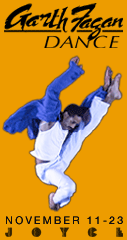
 |

|
 |

|
 |
 |
 |
 |
Go back to Flash Reviews Post-modern at the Met By Susan Yung NEW YORK -- It makes for a combustible mix when modern dance meets the opera crowd on the latter's turf. The Metropolitan Opera recently commissioned Doug Varone to re-choreograph "Le Sacre du Printemps," one third of a Stravinsky evening conducted by Valery Gergiev, with sets and costumes by David Hockney. Seen October 13, the program, originally presented in 1981 on the occasion of the centenary of Stravinsky's birth, was balanced out by "Le Rossignol" (choreographed by Frederick Ashton, and danced by Julie Kent and Damian Woetzel) and "Oedipus Rex," in a production with almost no movement at all. People sitting nearby this reviewer made some uncharitable comments about this "Sacre du Printemps," but Varone honored the austerity of the story and created a compelling dance theater piece on a grand scale. Varone has caught the eye of several opera companies by now, having choreographed for New York City Opera, Opera Colorado, and Washington Opera, in addition to the Met. It's easy to see why -- his nontraditional movements capture basic human emotions with great economy and little fuss, and they can be read legibly from a distance. For "Le Sacre du Printemps," he set the timeframe just past the evolution of homosapiens' bipedalism; the dancers wore face paint and earth-hued costumes. Nina Watt and Larry Hahn portrayed the sages, or tribal leaders. The two gangs, comprising women and men, began piled atop one another, arms rippling in waves, pushing our gaze along like a beach-ball in a crowd. Varone is a good match for Stravinksy. He choreographs movement in fits and starts, at times all punctuation, at other times flowing phrases with strong anchored elements. He moved the crowd in obedient lines and circles, and split it into small groups which took turns initiating flickering motions so the audience's eye darted from one part of the stage to the other. After a series of tests that would be a match for any Broadway cattle call, the sages chose Adrian Fang and Eddie Taketa as the lucky chosen ones. They danced in tandem, seemingly torn limb from limb, flinging themselves to the stage without care. Many versions of "Le Sacre du Printemps" seem revolutionary, simply because the score still sounds radical after 90 years. Here, Varone has stripped the narrative to the basics and presented it devoid of contemporary pretense or gender chauvinism. In stark contrast, "Le Rossignol," choreographed by Frederick Ashton and based on a fairy-tale by Hans Christian Anderson, was like a box of petits fours -- one confection next to another, each made of layer upon layer of baby blue icing. The story tells of a sweet-singing nightingale replaced by a mechanical bird, with the nightingale's artistry triumphing in the end. Hockney's eye-popping set featured cleverly: performers carried staffs with giant simplified masks; these behaved as huge surrogate heads, leaning toward the emperor in rapt attention; others brandished illuminated pineapples. New York City Ballet's Damian Woetzel, in the role of the fisherman, sat in the middle of a circle over which a fantastic silken banner depicting Chinese architectural elements descended. The elegant Julie Kent (of American Ballet Theatre) as the nightingale emerged from a tree, languid arms rippling, head darting to and fro. Both dancers excelled at the physical acting required to convey character through movement. Woetzel dances with a relaxed virtuosity like few others. Kent is so lithe and ethereal that she is sometimes subsumed by the sets or by other dancers, but this role played up her strengths and the direction allowed us to focus on her. Two singers stood in the pit with their heads visible, Barry Banks as the Fisherman and Olga Trifonova as the Nightingale, who sang with a crystalline sweetness. Additional characters sang and acted their roles onstage. The final act, "Oedipus Rex," featured a libretto written by Jean Cocteau after Sophocles, and was narrated by the actor Philip Bosco, who sat in an armchair just in front of the apron. Fifty-eight statue-like male chorus members anchored the black and red-hued set; they sat in two rows downstage in front of a platform on which the other singers performed. The near absence of movement proved frustrating after two such visually stimulating works, but the dynamic music, rendered spectacularly dramatic by Gergiev's conducting, at least pleased the audience's opera purists, who seemingly had deemed "Le Sacre du Printemps" the chosen one, ready to sacrifice. David Kneuss stage directed; Wayne Chouinard designed the lighting. |
|||||||


